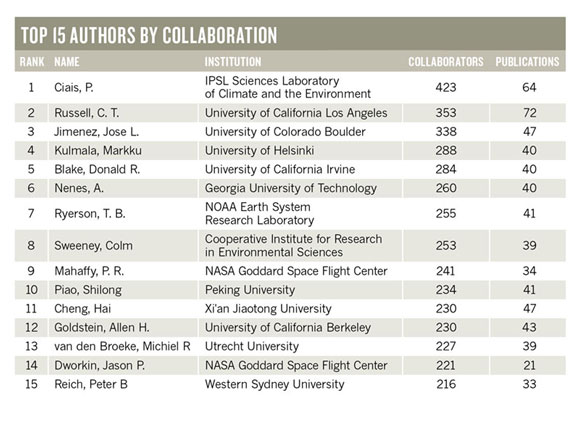
Scientists build green connections
Networks of researchers across disciplines and across the world are working to solve some of humanity's biggest problems.
29 June 2018
Research in the Earth and environmental sciences is highly interdisciplinary, as this graphic of the most highly collaborative authors in the field shows. (It may take a moment to load.)
To see individual authors and their connections, hover your mouse over the infographic.
Each of the 4,070 nodes in the network represents an individual author. Each of the authors has collaborated with at least 40 other authors on Earth and environmental science articles published in journals tracked by the Nature Index between 2012 and 2017. Authors are coloured according to their primary discipline.
Denser clusters indicate higher frequency of collaboration between authors in the cluster. The size of the nodes denotes the number of co-authors for each author.
More characteristics of the author's network, as well as the institutional affiliation of highlighted authors, can be seen from the following static representations of the same data, also provided by Dimensions from Digital Science.

Dimensions from Digital Science

More features emerge from a closer look at the network:

Dimensions from Digital Science
The density of different-coloured nodes in this cluster indicates the most highly collaborative and interdisciplinary group of authors in Earth and environmental science articles tracked by the Nature Index. Authors in the chemical sciences, engineering and Earth sciences predominate in this group.
Dimensions from Digital Science
This cluster represents a highly collaborative group of physical scientists. Christopher Russell (2), of the University of California, Los Angeles, the second most collaborative author in the entire network, forms a crucial link between this group of physicists and a group of Earth scientists to the left. Paul Mahaffy (9), of the NASA Goddard Space Flight Center, is a key connector between the cluster of physicists to the right and a group of Earth scientists and chemical scientists to the left.
Dimensions from Digital Science
These two constellations represent intra-disciplinary collaboration within two distinct groups of environmental scientists. Peter Reich (15) of Western Sydney University, is an important connector with multiple groups elsewhere in the network.
Dimensions from Digital Science
This collaborative group of biological scientists work in relative isolation from the rest of the network.
Dimensions from Digital Science
The even spread and diverse mix of disciplines in this area, and the near absence of researchers in Earth and environmental sciences, shows authors collaborating across engineering, biological, medical and health sciences on environment-related research.This infographic was produced for Nature Index 2018 Earth and Environmental Sciences. You can read more stories here.
